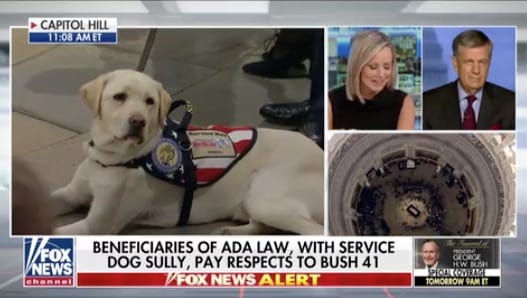By Eric London
[dropcap]T[/dropcap]he lying campaign by the ruling class to mythologize George H.W. Bush reached absurd new heights with the elevation of his service dog, “Sully,” as a symbol of mourning and national unity.
In the absence of any sympathetic humans who were ever associated with the deceased ex-president, a dog has become the chief mechanism through which the political establishment is seeking to convince an uninterested population to honor one of America’s least popular presidents.
On Tuesday night, Bush family publicity agent Jim McGrath tweeted a photo of the Labrador retriever lying down near Bush’s flag-draped casket in Texas. Though poor Sully probably thought he was just taking a nap, his photograph was picked up by nearly every newspaper, website or television program in America within several hours. A Google search for “Sully the dog” now yields over 50 million results.
The headlines tearfully proclaimed: “Watch Sully the dog say goodbye one last time,” “Sully the dog proves that love conquers all,” “‘Mission complete’: Sully the service dog accompanies Bush one last time.”
NPR hosted a roundtable discussion with dog experts to determine how much Sully really loved his master. Fox News nobly rose above partisan bickering: “George H.W. Bush’s dog Sully isn’t a Democrat or Republican.”
When Bush’s casket was flown from Texas to Washington DC to lie in the capitol rotunda, Sully was brought along. CSPAN filmed him walking on the tarmac at Joint Base Andrews. Cable news programs featured live “breaking news” coverage when Sully arrived at the capitol, entering the rotunda to the somber tune of “taps,” flanked by a wall of saluting war veterans.
When Sully ambled in—sporting an American flag bib embroidered with the presidential seal—the rotunda echoed with the sound of camera shutters from the assembled press gaggle. An emotional CNN “political analyst” declared that with this patriotic display, Sully had “really captured the imagination of the country.”
The Washington Post published this Hemingway-esque report on Sully’s solemn entrance:
“George H.W. Bush’s flag-draped coffin was flanked by rifle-bearing troops before they were joined by Sully, his paws quietly shuffling across the polished Capitol Rotunda floor.”
When Sully entered, “He sat and looked around at a crowd both large and silent, then lay for a moment. The dog appeared woebegone, his head slack over his front left paw, his muzzle resting on the ground. Yet he was also steadfast, still keeping watch over Bush.
“The display of instinctual, animalistic devotion captured the reaction to Bush’s death in a way that the words spilled all weekend over the Internet could not.”
Forthcoming Pulitzer Prizes aside, the elevation of Sully the dog as a propaganda symbol underscores several truths about the degraded character of American political life.
Like everything else about the press coverage of Bush’s death, even the Sully story was based on lies. Though press accounts described Bush and Sully’s “forever friendship,” the Bush family only bought Sully in July, and when intrepid Slate reporter Ruth Graham dared point out that the now-famous photo “says almost nothing other than the fact that Sully was, at one point in the same room as the casket of his former boss,” Slate came under heavy fire, fielding thousands of angry messages and tweets.
The episode is a public relations ploy aimed cynically at tugging the heartstrings of onlookers who otherwise felt no particular sympathy for Bush, his family, or the funeral attendees.
Those in attendance were a “who’s who” of the most hated politicians in America: George W. Bush, Dick Cheney, Colin Powell, Condoleezza Rice, Karl Rove, Barack Obama, Donald Trump and Hillary Clinton. If one were to lock the doors at the funeral, empanel a jury and bring in a judge, most of the distinguished guests could be tried for war crimes.
None of these hated figures could serve as media icons around which Americans could be expected to rally. And so, through psychological sleight of hand, the propagandists in charge of the funeral are trying to dupe viewers into transposing their love for man’s best friend with support for one of America’s worst presidents.
But the political establishment is using the Bush funeral media hype to serve a broader political purpose.
As with the funeral of John McCain in August, the official canonization of leading political figures is not primarily to humanize the deceased themselves, but to legitimize the state, its institutions and the authority of the ruling class. Like coronation ceremonies and royal weddings in a monarchy, the official mourning periods are intended to poison the atmosphere with nationalism and paper over social tensions arising from gaping levels of social inequality with phony calls for “unity.”
As for Sully, he will forever remain by far the most popular member of the Bush family to have ever lived.

This work is licensed under a Creative Commons Attribution-NonCommercial 4.0 International License
![]()
[premium_newsticker id=”154171″]
Revolutionary wisdom







